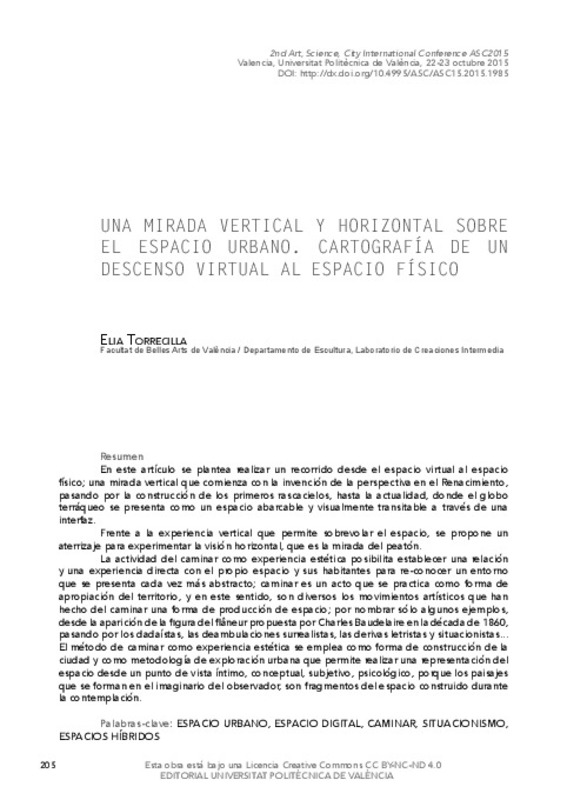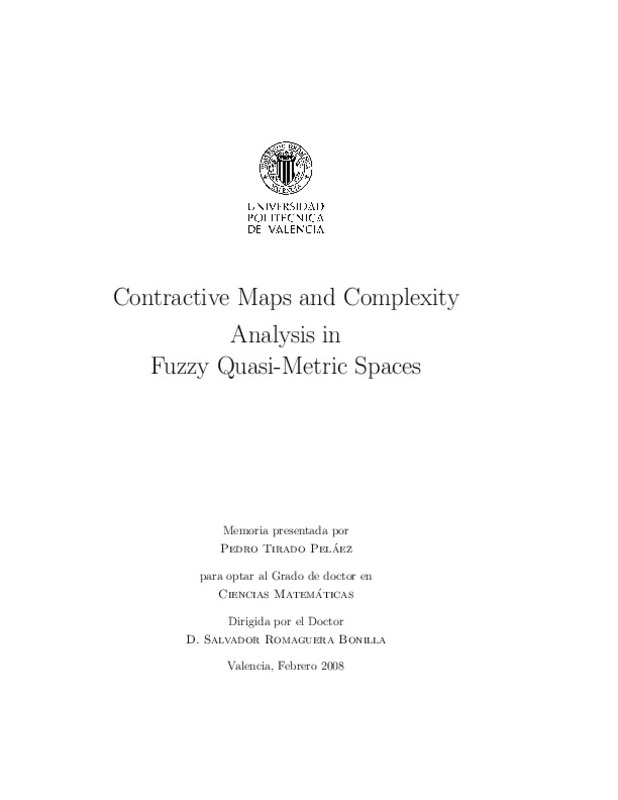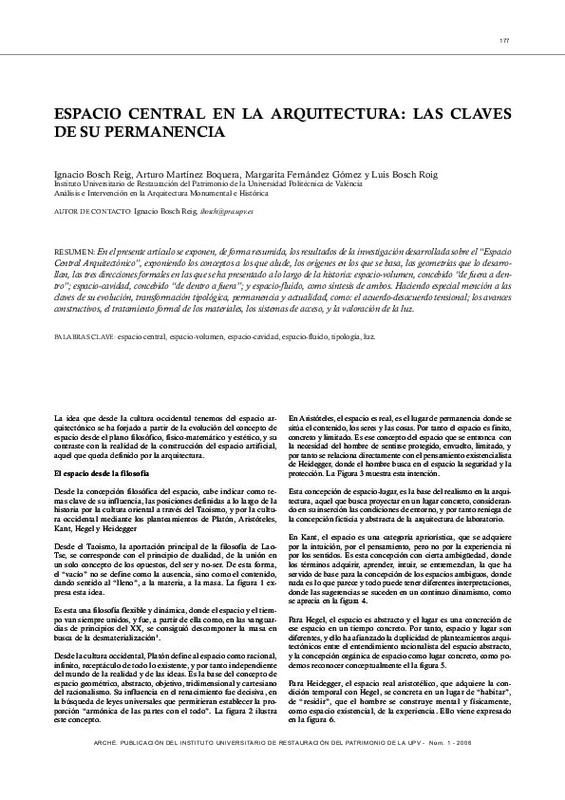JavaScript is disabled for your browser. Some features of this site may not work without it.
Buscar en RiuNet
Listar
Mi cuenta
Estadísticas
Ayuda RiuNet
Admin. UPV
UNA MIRADA VERTICAL Y HORIZONTAL SOBRE EL ESPACIO URBANO. CARTOGRAFÍA DE UN DESCENSO VIRTUAL AL ESPACIO FÍSICO
Mostrar el registro sencillo del ítem
Ficheros en el ítem
| dc.contributor.author | Torrecilla Patiño, María Elia
|
es_ES |
| dc.date.accessioned | 2018-01-31T12:48:28Z | |
| dc.date.available | 2018-01-31T12:48:28Z | |
| dc.date.issued | 2015-11-17 | |
| dc.identifier.isbn | 9788490484562 | |
| dc.identifier.uri | http://hdl.handle.net/10251/96313 | |
| dc.description.abstract | [EN] This article poses a tour from the virtual space to physical space; a vertical sight that begins with the invention of perspective in the Renaissance, through the construction of the first skyscrapers, to the present, where the globe is presented as an understandable and visually passable through an interface space. Faced with the vertical experience that allows fly space, a landing is proposed for horizontal viewing experience, which is the look pedestrian. The activity of walking as an aesthetic experience enables the relationship and experience with the space itself and its inhabitants to re-learn an environment that has increasingly abstract; Walking is an act that is practiced as a form of appropriation of the territory, and in this sense, are diverse artistic movements that have made the walk a form of production space; to name a few examples, since the appearance of the figure of the flâneur proposed by Charles Baudelaire in the 1860s, to the Dadaists, the surrealists wanderings, the lyricists and Situationists drift ... The method of walking as an aesthetic experience is a form of construction of the city and urban exploration methodology, reflecting through this action a representation of space from an intimate, conceptual, subjective, psychologically point of view, because the landscapes formed in the imagination of the viewer, are fragments of the space created during the contemplation. | es_ES |
| dc.description.abstract | [ES] En este artículo se plantea realizar un recorrido desde el espacio virtual al espacio físico; una mirada vertical que comienza con la invención de la perspectiva en el Renacimiento, pasando por la construcción de los primeros rascacielos, hasta la actualidad, donde el globo terráqueo se presenta como un espacio abarcable y visualmente transitable a través de una interfaz. Frente a la experiencia vertical que permite sobrevolar el espacio, se propone un aterrizaje para experimentar la visión horizontal, que es la mirada del peatón. La actividad del caminar como experiencia estética posibilita establecer una relación y una experiencia directa con el propio espacio y sus habitantes para re-conocer un entorno que se presenta cada vez más abstracto; caminar es un acto que se practica como forma de apropiación del territorio, y en este sentido, son diversos los movimientos artísticos que han hecho del caminar una forma de producción de espacio; por nombrar sólo algunos ejemplos, desde la aparición de la figura del flâneur propuesta por Charles Baudelaire en la década de 1860, pasando por los dadaístas, las deambulaciones surrealistas, las derivas letristas y situacionistas... El método de caminar como experiencia estética se emplea como forma de construcción de la ciudad y como metodología de exploración urbana que permite realizar una representación del espacio desde un punto de vista íntimo, conceptual, subjetivo, psicológico, porque los paisajes que se forman en el imaginario del observador, son fragmentos del espacio construido durante la contemplación. | es_ES |
| dc.format.extent | 5 | es_ES |
| dc.language | Español | es_ES |
| dc.publisher | Editorial Universitat Politècnica de València | es_ES |
| dc.relation.ispartof | Actas Segundo Congreso Internacional Arte Ciencia Ciudad ACC2015 | es_ES |
| dc.rights | Reconocimiento - No comercial - Sin obra derivada (by-nc-nd) | es_ES |
| dc.subject | Espacio urbano | es_ES |
| dc.subject | Espacio digital | es_ES |
| dc.subject | Caminar | es_ES |
| dc.subject | Situacionismo | es_ES |
| dc.subject | Espacios híbridos | es_ES |
| dc.title | UNA MIRADA VERTICAL Y HORIZONTAL SOBRE EL ESPACIO URBANO. CARTOGRAFÍA DE UN DESCENSO VIRTUAL AL ESPACIO FÍSICO | es_ES |
| dc.type | Capítulo de libro | es_ES |
| dc.type | Comunicación en congreso | es_ES |
| dc.rights.accessRights | Abierto | es_ES |
| dc.contributor.affiliation | Universitat Politècnica de València. Departamento de Escultura - Departament d'Escultura | es_ES |
| dc.description.bibliographicCitation | Torrecilla Patiño, ME. (2015). UNA MIRADA VERTICAL Y HORIZONTAL SOBRE EL ESPACIO URBANO. CARTOGRAFÍA DE UN DESCENSO VIRTUAL AL ESPACIO FÍSICO. En Actas Segundo Congreso Internacional Arte Ciencia Ciudad ACC2015. Editorial Universitat Politècnica de València. 205-209. http://hdl.handle.net/10251/96313 | es_ES |
| dc.description.accrualMethod | OCS | es_ES |
| dc.relation.conferencename | 2º Congreso Internacional ACC: Arte, Ciencia, Ciudad | es_ES |
| dc.relation.conferencedate | October 22-23,2015 | es_ES |
| dc.relation.conferenceplace | Valencia, Spain | es_ES |
| dc.relation.publisherversion | http://ocs.editorial.upv.es/index.php/ASC/ASC15/paper/view/2040 | es_ES |
| dc.description.upvformatpinicio | 205 | es_ES |
| dc.description.upvformatpfin | 209 | es_ES |
| dc.type.version | info:eu-repo/semantics/publishedVersion | es_ES |
| dc.relation.pasarela | OCS\2040 | es_ES |









